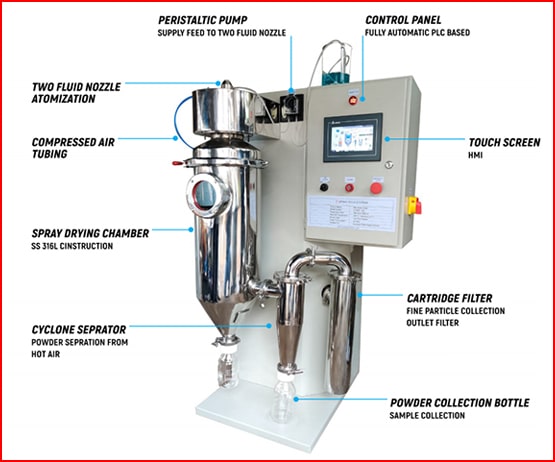Spray Drying solutions for R & D and Production
Mumbai, Maharashtra
Monday to Saturday

The food sector realises the importance of the laboratory spray dryer, so demand is rising proportionally. During the projected period of 2020-2024, the food industry equipment market is expected to increase by USD 450 million, with a CAGR of 5%. How would you choose a spray drier appropriate for your food type as a manufacturer? Different types of dryers (e.g., pressure single-fluid nozzle atomiser, pneumatic two-fluid nozzle atomiser, rotary wheel atomiser) with drying stages (e.g., two-stage spray dryer, single-stage spray dryer, multi-stage spray dryer) have different functions in food applications (e.g., milk products, plant products, fish and meat proteins, algae, -carotene, chelates, cultures, emulsifier, For example, spray dryers manufacturers design there are many different types of dryers available to preserve fruit and vegetable juices in powder form, each with its own set of features to meet the needs of the maker, as improper use could impair the product's physicochemical and microstructural properties.
When choosing a suitable lab spray dryer, there are several aspects to be considered. One of the most important things to consider when purchasing a spray dryer is its convenience (i.e., how easy it is to control particle size) and the setup and cleaning needs. After the fundamentals have been taken care of, the functional component should be considered. It is preferable to use simple equipment to operate, adapt, and develop optimal conditions. The following are the primary functions that the instrument should enable you to control:
1. Ensure that the airflow, temperature, and pump speed are all within acceptable limits.
2. The volume should be equal to the air compressor pressure.
3. The amount of API necessary for the development
4. The API's sturdiness and behaviour
5. Required amount of dry mix formulation
6. The amount of encapsulant and the solid content of the activity will determine the overall batch size.
7. The type of drying gas required will be determined by the solvent employed to create the emulsion, air or nitrogen.
Optimisation
Industrial spray dryers manufacturers in Mumbai usually optimise the spray dryer in one of three ways. To begin with, it is done to maximise manufacturing quality and yield. This can be accomplished by adjusting the temperature of the inlet, outflow, and feed. Second, optimisation is essential to reduce productivity losses, such as those caused by Clean in Place (CIP). Finally, spray dryers perform better because the amount of moisture in the ambient air is higher in the winter.
Increasing your ability
The amount of water that the spray dryer evaporates is measured at the moment of wet product loading to determine its capabilities. The temperature differential between the inlet and output must be increased for optimal evaporation.
The CIP nozzle valve has a retractable design:
The build-up can happen in spray dryer vessels at a specific outlet temperature. They do not work with exceptionally high intake temperatures, even though greater inlet temperatures increase energy efficiency. Furthermore, the product must not be denatured, burnt, or devoid of nutrients or desirable properties.
Run time has been improved:
A solid optimal production should run on a well-planned schedule with very little or no unplanned downtime. A feed system that is frequently swapped between Products and batches should be washed regularly. On the other hand, spray drying should be closely monitored for allergies and thoroughly cleaned between allergy-producing batches.
Spray dryers with feeds that function at 100% capacity have just become available, making them ideal for automated nozzle systems. An atomiser can be made with a rotary or nozzle, and when one feed system is switched off, other nozzles can be used.
Proper Cleaning
Cleaning should be done regularly either between batches for the reasons listed below.
• To avert an explosion or fire caused by an overabundance of material.
• Excessive build-up might lead to quality problems and cross-contamination.
• To keep the chamber free of microbial development.
• To eliminate maintenance concerns that aren't necessary.
Environmental factors:
Seasonal variance has a significant impact on the spray dryer's effectiveness. As a result, standardising the incoming air is critical for year-round production. The overall moisture in the air as it leaves the chamber limits the dryer's capacity. For or while making a stable product, the air leaving the container should not be excessively moist, as this could result in a clumsy result. Furthermore, the container should run at the highest overall moisture content possible to ensure maximum efficacy. The introduction states that characteristics such as intake and output temperature and other parameters should be optimised for theoretical maximum productivity even during seasonal fluctuations.
A few components can be used to control this. First, it is necessary to determine the ambient temperature moisture content using a hygrometer and the air volume. The total volume of evaporated water contribution is calculated. Mechanical inefficiencies and slipping also account for a flowmeter for enhanced accuracy. Finally, all operational data must be gathered in order to fully comprehend the machine, determine if it is running at its optimal level, and determine if the product yield is comparable to theoretical values. Food research lab provides food consulting services to help you choose the best spray dryer manufacturers in India

Head of Innovation
Lorem Ipsum is simply dummy text of the printing and typesetting industry. Benenatis mauris. Vestibulum ante ipsum primis in industry, logistics, finance, business orci ultrices venenatis mauris.
Marketing
92%
Marketing
82%